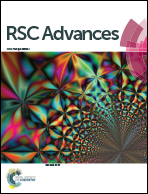Catalytically active nanosized Pd9Te4 (telluropalladinite) and PdTe (kotulskite) alloys: first precursor-architecture controlled synthesis using palladium complexes of organotellurium compounds as single source precursors†
Abstract
Several intermetallic binary phases of Pd–Te including Pd3Te2, PdTe, PdTe2, Pd9Te4, Pd3Te, Pd2Te, Pd20Te7, Pd8Te3, Pd7Te2, Pd7Te3, Pd4Te and Pd17Te4 are known, and negligible work (except few studies on PdTe) has been done on exploring applications of such phases and their fabrication at nanoscale. Hence, Pd(II) complexes Pd(L1)Cl2 and Pd(L2-H)Cl (L1): Ph–Te–CH2–CH2–NH2 and L2: HO–2-C6H4–CH![[double bond, length as m-dash]](https://www.rsc.org/images/entities/char_e001.gif) N–CH2CH2–Te–Ph were synthesized. Under similar thermolytic conditions, complex Pd(L1)Cl2 with bidentate coordination mode of ligand provided nanostructures of Pd9Te4 (telluropalladinite) whereas Pd(L2-H)Cl with tridentate coordination mode of ligand yielded PdTe (kotulskite). Bimetallic alloy nanostructures possess high catalytic potential for Suzuki coupling of aryl chlorides, and reduction of 4-nitrophenol. They are also recyclable upto six reaction cycles in Suzuki coupling.
N–CH2CH2–Te–Ph were synthesized. Under similar thermolytic conditions, complex Pd(L1)Cl2 with bidentate coordination mode of ligand provided nanostructures of Pd9Te4 (telluropalladinite) whereas Pd(L2-H)Cl with tridentate coordination mode of ligand yielded PdTe (kotulskite). Bimetallic alloy nanostructures possess high catalytic potential for Suzuki coupling of aryl chlorides, and reduction of 4-nitrophenol. They are also recyclable upto six reaction cycles in Suzuki coupling.

- This article is part of the themed collection: 2021 Outstanding Student Paper Awards


 Please wait while we load your content...
Please wait while we load your content...